Social media platforms like Facebook have become indispensable tools for staying connected, fostering engagement, and building communities. For educational institutions, especially those keen on strengthening ties with their alumni, a well-maintained and strategically utilized Facebook presence can be a game-changer.
As of September 2017, Facebook had more than 2 billion monthly active users, an increase of 16% over the previous year. What’s more, 66 percent of those Facebook users — that’s 1.37 billion people — log in every day. According to research from Sprout Social, it’s the preferred network among Millennials, Gen Xers, and Baby Boomers alike.
Even more important for advancement offices, 79% of Facebook users hold a higher-education degree.
You might think of Facebook as just a personal social networking tool, but it started out as a social networking site for college students. This is a huge advantage for advancement professionals — most Facebook users are already used to interacting with their school on the platform.
With such a huge user base, Facebook is a huge part of the marketing strategy for most businesses — and should be for advancement offices too.
Creating an Alumni Facebook Page: The Foundation of Engagement
The cornerstone of any successful alumni engagement strategy on Facebook is the establishment of a dedicated alumni Facebook page. This page serves as a virtual hub where alumni can congregate, reminisce, and stay informed about the latest happenings related to their alma mater. The alumni page becomes the digital manifestation of the institution's community spirit, connecting graduates from various years and geographical locations.
The alumni relations team plays a pivotal role in curating content for the alumni Facebook page. Regularly updating the page with relevant posts, news, and stories ensures that the community remains active and engaged. From showcasing alumni excellence to sharing the latest developments on campus, every piece of content should be tailored to resonate with the diverse interests of the alumni audience.
Spotlight Alumni Success Stories
People love reading about themselves and people like them. Having the same alma mater already gives people a sense of community, and hearing stories about what other alumni are up to can strengthen that bond.
A dedicated alumni page is the perfect place to share stories about alumni excellence — and highlight the diverse fields occupied by graduates of the same school.
George State University features stories about what their alumni are up to:
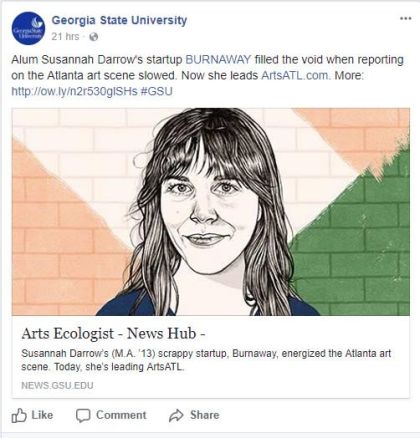
Columbia’s Alumni Association also shares stories about alumni in the news.

Get Alumni Involved With Interactive Content
Facebook is built around online interaction between people, so starting a conversation is always a great idea. But sometimes just throwing an idea or a question out there isn’t enough. You might get a few “likes,” but unless a few people get the ball rolling, it’s usually … crickets.
Fortunately, Facebook has a few features you can use to pull your alumni audience more actively into your content.
Polls
You can use Facebook’s polling feature to ask a question and get people to vote on answers. Neumann University Alumni Association created a poll on their Facebook page and asked alumni to vote on the design of their Homecoming 2017 T-shirt design:
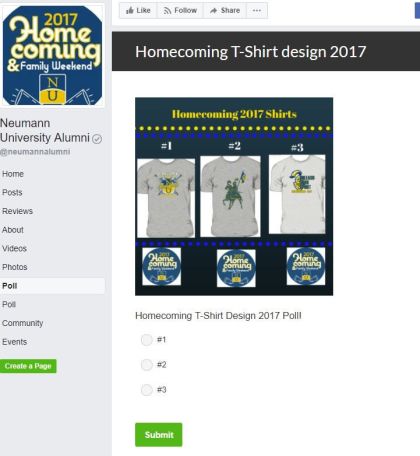
The beauty of polls is that they also create a curiosity loop. People want to check back in for the results and see how their answers are stacked up against the rest of the community.
Tags
Facebook’s tagging feature is a great way to expand a post’s reach. When you tag individual alumni members, not only do they get a notification, but so does everyone in their network.
But you can also invite alumni to tag themselves and their friends. The University of Wollongong in Australia posted pictures from a recent graduation ceremony, and invited alumni to tag themselves and their classmates:
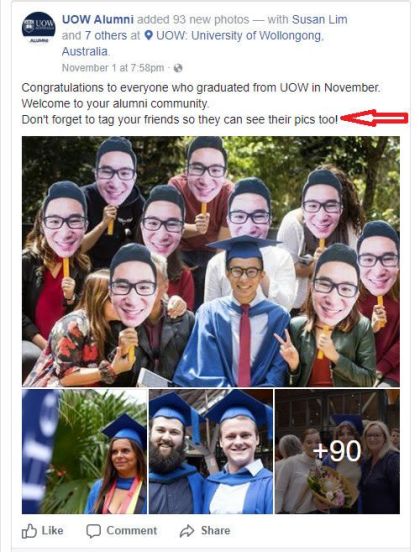
Engaging Alumni Through User-Generated Content
One of the most effective ways to engage alumni on Facebook is by encouraging user-generated content. Alumni-generated content adds a personal touch to the page, allowing graduates to share their unique experiences and perspectives. Whether it's a heartfelt testimonial, photos from their college days, or updates on their professional achievements, user-generated content fosters a sense of ownership within the alumni community.
To boost user-generated content, the alumni relations team can initiate themed campaigns or challenges, prompting alumni to share their stories and memories. This not only enriches the content on the alumni Facebook page but also strengthens the bonds between alumni and their alma mater. Alumni engagement becomes a reciprocal process, with the institution providing a platform for sharing, and alumni contributing their content.
The University of Technology Sydney used the cover photo on their alumni page to promote a contest for the best selfie photo taken at a recent graduation ceremony. Alumni were asked to share their selfies and vote for their favorite. The graduate whose selfie got the most “likes” won a $200 voucher.
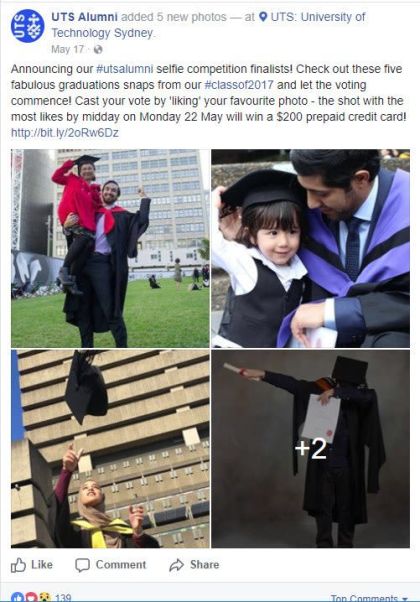
Engaging Alumni Through User-Generated Content
One of the most effective ways to engage alumni on Facebook is by encouraging user-generated content. Alumni-generated content adds a personal touch to the page, allowing graduates to share their unique experiences and perspectives. Whether it's a heartfelt testimonial, photos from their college days, or updates on their professional achievements, user-generated content fosters a sense of ownership within the alumni community.
To boost user-generated content, the alumni relations team can initiate themed campaigns or challenges, prompting alumni to share their stories and memories. This not only enriches the content on the alumni Facebook page but also strengthens the bonds between alumni and their alma mater. Alumni engagement becomes a reciprocal process, with the institution providing a platform for sharing, and alumni contributing their content.
The University of Technology Sydney used the cover photo on their alumni page to promote a contest for best selfie photo taken at a recent graduation ceremony. Alumni were asked to share their selfies and vote for their favorite. The graduate whose selfie got the most “likes” won a $200 voucher.
Strategic Posting: The Key to Sustained Engagement
Engaging alumni on Facebook requires a thoughtful approach to posting content. From photos of campus events to updates on faculty achievements, the content should be diverse, relevant, and timely. Regularly scheduled posts keep the alumni community informed and excited about what's happening at their alma mater.
For example, the alumni relations team can post content related to sporting events, encouraging alumni to reminisce about their college days and share their own experiences. This not only sparks nostalgia but also taps into the collective passion for their alma mater, fostering a strong sense of community.
Utilizing the cover photo as prime real estate for highlighting key events, achievements, or milestones adds a visual element to the page. A well-designed cover photo not only enhances the page's aesthetic appeal but also serves as a powerful storytelling tool.
Harnessing the Power of Hashtags
In the vast world of social media, hashtags play a crucial role in content discoverability and engagement. Relevant hashtags make it easier for alumni to find and participate in discussions related to their alma mater. The alumni relations team should create and promote specific hashtags that resonate with the alumni community and encourage its widespread use.
For instance, a hashtag like #AlumniExcellence can be used to showcase the professional achievements of alumni, creating a thread of success stories that inspires current students and engages the broader alumni community. By consistently incorporating relevant hashtags, the visibility of the alumni Facebook page is enhanced, making it more accessible to a wider audience.
Promote Alumni Events and Campaigns With Videos
According to research from Buzzsumo, Facebook posts that include videos are more likely than any other type of content to be shared. We’ve all seen our share of viral cat videos, but advancement teams can use video to great effect when promoting alumni events and campaigns.
Facebook Live, in particular, is an important tool. Because Facebook’s algorithm favors native videos, Facebook Live video posts are more likely to show up in your followers’ newsfeeds.
You can use Facebook Live to provide updates during specific campaign drives, like #GivingTuesday. Live video helps amp up the excitement for activities like donor challenges.
You can also broadcast alumni events live — like the following London Business School Alumni event — so that members who can’t attend don’t have to miss out completely.
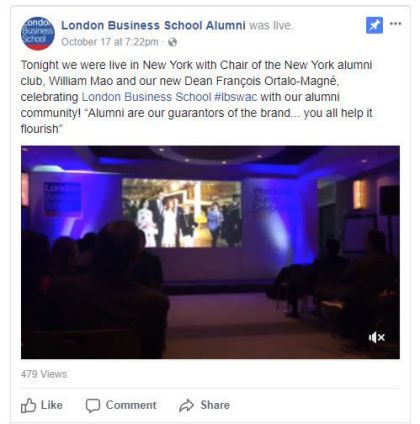
Consider using Facebook videos to amplify your larger alumni campaigns, too. Here’s how Oxford University promoted their Three Little Words campaign to their alumni community:

Videos showing the impact of specific fundraising campaigns — like this one, also from Oxford University — can have a much more visceral impact than any annual report.
A note on promoting events: Using Facebook’s Events functionality is an excellent way to amplify your alumni or fundraising events. Your members can see upcoming events at a glance, but more importantly, their response amplifies your event’s reach. When a member RSVPs (or expresses interest), their network — which may include former classmates — sees it too.
Simply click on Events in the left navigation pane, then click the Create an Event button.
Increase Offline Engagement With Call-to-Action Buttons
Using Facebook’s call-to-action feature is another way for you to take your alumni engagement further, off the Facebook page.
The call-to-action feature allows page owners to embed an interactive button on their page that links to any destination (on or off Facebook) they choose.
For example, you can use the Sign-up button on your Facebook page to collect contact information. McGill University uses this button on their Alumni home page to link to a page on their website where alumni can create or update their alumni profile:
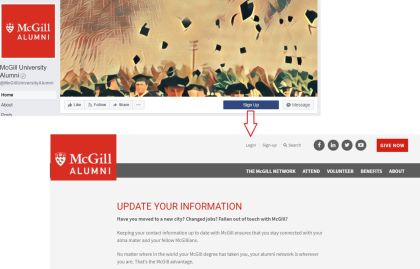
The London Business School uses the Learn More button to take users to a dedicated alumni page on their school’s website, drawing them deeper into their alumni community.
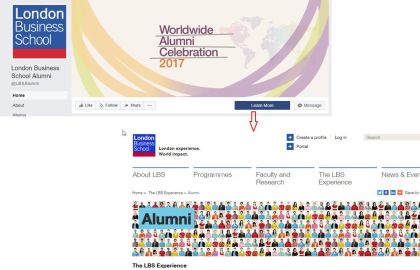
And you can be even more direct with your call-to-action buttons, like the Cornell Alumni Association. They use a Donate button prominently displayed on their Facebook page to link directly to a secure donation site:
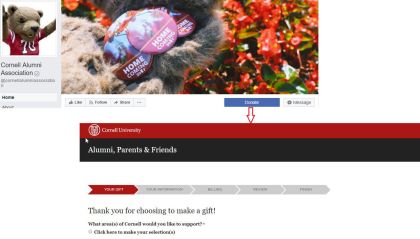
Cross-Promotion and Collaboration: Extending Reach and Impact
Collaboration is a powerful tool for expanding the reach and impact of an alumni Facebook page. Advancement teams, responsible for fostering relationships with alumni, can collaborate with other departments or groups within the institution to cross-promote events or initiatives. For example, partnering with the advancement office to promote fundraising campaigns through the alumni page not only raises awareness but also encourages alumni to contribute to the betterment of their alma mater.
Moreover, cross-promotion can extend beyond the confines of the institution itself. Engaging with other alumni's Facebook pages, especially those of schools with similar values or histories, creates a network of interconnected communities. This not only diversifies the content available to alumni but also exposes them to a broader spectrum of experiences within the larger academic world.
Encouraging Alumni to Stay Connected: The Role of Events
Organizing and promoting events through the alumni Facebook page provides a huge opportunity for engagement. Whether it's a virtual reunion, a networking event, or an alumni lecture series, events offer a platform for alumni to reconnect with each other and with the alma mater. The alumni relations team can leverage Facebook's event feature to create, promote, and manage these gatherings efficiently.
Sharing event details, photos, and follow-up content on the alumni Facebook page ensures that even those who couldn't attend physically remain connected and engaged. The sense of community is strengthened as alumni come together, whether in person or virtually, to celebrate shared experiences and milestones.
Incorporating Multimedia for Maximum Impact
Incorporating multimedia elements such as photos and videos is crucial for capturing the attention of the alumni audience. Posting engaging videos, such as interviews with prominent alumni or highlights from campus events, adds a dynamic dimension to the content.
The alumni relations team can also encourage alumni to share their videos, providing a platform for diverse voices and perspectives. These multimedia elements not only break the monotony of text-based posts but also cater to different preferences within the alumni community.
The Importance of Comments and Connections
Alumni engagement on Facebook is not a one-way street. Encouraging alumni to comment on posts, share their thoughts, and connect creates a vibrant and interactive community. The alumni relations team should actively respond to comments, providing alumni with a sense of openness and dialogue.
Creating discussion threads around relevant topics, whether related to current events or nostalgic memories, stimulates engagement. By actively participating in these discussions, alumni feel valued and heard, strengthening their connection with the institution.
The Power of Alumni Networks: Extending Engagement Beyond Facebook
While Facebook is a powerful platform for engaging alumni, it's essential to recognize the potential of other online and offline platforms. The alumni relations team can leverage the alumni Facebook page to promote the institution's broader online presence, including the official website, LinkedIn groups, and other social media channels.
Encouraging alumni to join professional networking platforms expands their connections and provides additional avenues for engagement. By strategically linking to the institution's website and other relevant platforms, the alumni Facebook page becomes a gateway to a comprehensive alumni network.
Nurturing Lasting Connections
Engaging alumni on Facebook is not just a digital endeavor; it's a dynamic process of nurturing lasting connections and fostering a sense of community. The alumni Facebook page serves as a bridge between past and present, providing a space for shared memories, achievements, and aspirations. By implementing these practices and continually evolving with the changing landscape of social media, educational institutions can create a thriving alumni community that stands as a testament to the enduring bond between alumni and their alma mater.
